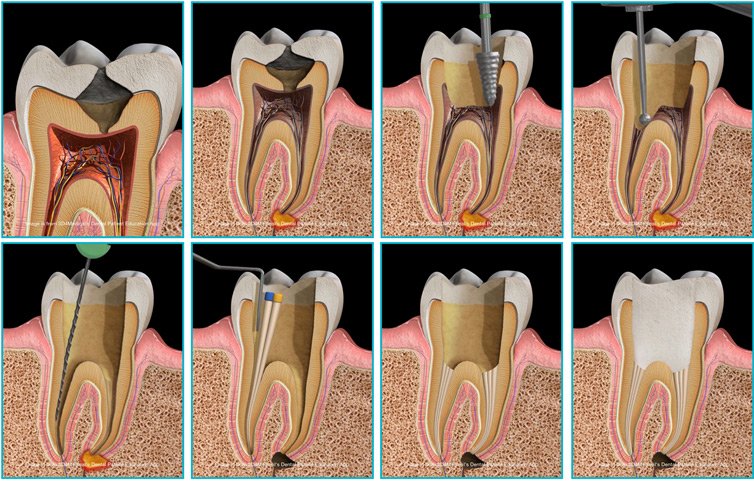What is Endodontics?
Endodontics is a branch of dentistry that deals with and treats various dental problems that have progressed to the dental pulp. Teeth, which have an important place in human life, are damaged over time due to various reasons.
One of the most serious and obvious of these damages is the decay of the tooth and loss of function. In this case, to ensure that the tooth can continue to function; Some treatments are applied.
Root canal treatment is the most common of these. If a tooth nerve is damaged by decay, impact, trauma or any other reason, the body accepts this non-living nerve as a foreign material and creates inflammation.
In such a case, it is necessary to remove the nerve and fill it with a filling material without leaving any gaps. This process is called root canal treatment.
If the inflamed and damaged nerve is not removed, it creates an infection in the tooth and surrounding tissues, and the tooth is lost. Cleaning the canal space by removing the pulp tissue; It is necessary to shape the canal and fill the canal with fillers.
These procedures are defined as endodontics and root canal treatment. Years ago, sick or damaged teeth were extracted. Today, even lost teeth can be saved in root canal treatment.
The most common causes of pulp damage are:
- Cracked tooth,
- Deep caries,
- Damage to the tooth, such as a serious blow to the tooth in the past or recent.
When the pulp becomes infected or dies, it must be treated. Otherwise, pus may accumulate, forming an abscess in the jawbone at the root of the tooth. The abscess destroys the bone surrounding the tooth, causing pain.
In Which Situations Can Endodontic – Root Canal Treatment Be Applied?
- Spontaneous pain in the tooth,
- Pain that increases at night and does not go away even with painkillers,
- Long-term persistence of cold, hot sensitivity or pain triggered by external factors such as tooth contact,
- Swelling around the tooth, gums or lymph nodes due to inflammation,
- Fistula or tooth discoloration, etc., which occurs as a result of infection of the tooth. unusual differences; of treatment reasons.
How is Endodontic-Canal Treatment Performed?
Treatment consists of several steps, which may require more than one session depending on the situation.
These steps are:
- First, a hole is made in the back of the front tooth or in the crown of the molars or premolars.
- After the diseased pulp is removed (pulpectomy), the pulp cavity and root canals are cleaned, enlarged and shaped for canal filling.
- If more than one session is needed, a temporary filling is applied to the hole in the crown to protect the tooth between sessions.
- The temporary filling is then removed and the pulp cavity and canal are permanently filled.
- A tapered, rubbery material called gutta percha is inserted into each of the channels and usually held in place with cement (adhesive). Sometimes a metal or plastic rod can be placed inside the channel for structural support.
- In the last step, a crown is placed on the tooth to restore its natural appearance and shape. If the tooth is broken, post application may be necessary to repair the tooth before placing the crown.
How Long Does Endodontic-Canal Treatment Take?
Depending on the condition of the tooth, root canal treatment can be done in one or two sessions.
For an infected tooth, several sessions may be required to ensure that the infection is completely eliminated.
An uncomplicated root canal treatment is usually completed in a single session.
Does Endodontic-Canal Treated Tooth Pain?
During root canal treatment, the nerves of the tooth are removed, so a tooth that has had root canal treatment is not affected by external stimuli.
After the treatment, there may be slight pain or sensitivity in chewing for the first few weeks because the tooth needs time to heal like every tissue in our body.
What Should I Do If My Pain Is Not Gone?
If the pain still continues in the future, the canal filling may be incomplete or insufficient.
In this case, the root canal is cleaned by removing the root canal filling, which is often called ‘re-treatment’. And it is refilled.
If there is no result from this treatment, the tooth is treated with a surgical method called “root tip resection”.
Does Root Canal Treatment Kill The Tooth?
After the living tissue in the tooth is removed with root canal treatment, your tooth becomes numb to heat and cold.
However, it continues to function and attaches to the bone with the vessels or nerves coming from the jawbone and surrounding tissues.
With the help of a suitable filling or restoration after the treatment, you can chew very easily or use your tooth as a prosthetic foot.
Why Am I Trying, Let Me Have My Tooth Pulled Out!!
Some patients think it would be better if I had my tooth extracted instead of a bridge or implant or root canal treatment. No prosthesis can replace your own teeth.






